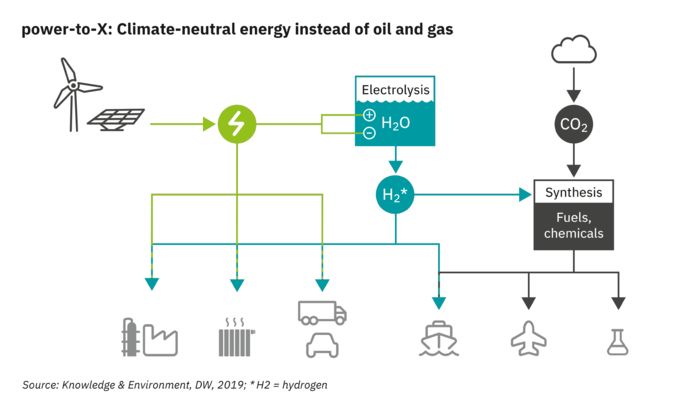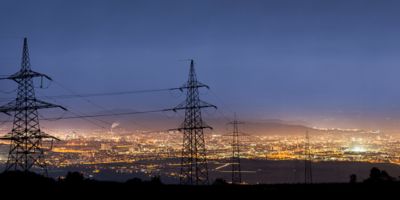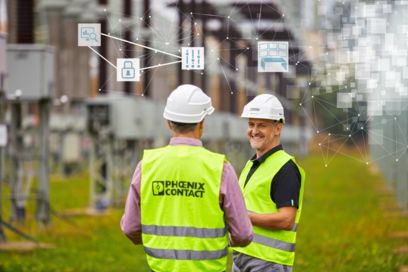What is power-to-liquid? Power-to-liquid (PtL/P2L) converts renewable energy into storable liquid fuels and reduces dependence on fossil fuels.

Brief summary
Power-to-liquid is a process in which renewable energy is used to produce hydrogen through electrolysis. This hydrogen is then converted with CO₂ into synthetic liquid fuels such as kerosene. PtL fuels are climate-neutral, can be used in existing infrastructures, and can replace fossil fuels.

How does power-to-liquid work?
During electrolysis, water is broken down into hydrogen and oxygen using renewable energy. In a further step, the hydrogen reacts chemically with carbon dioxide, which can be obtained from the atmosphere or industrial exhaust gases. The Fischer-Tropsch process, which has been used since 1925 to produce liquid fuels, is often used here. The synthetic fuel produced in this way can be used for the mobility sector or as a raw material for the chemical industry.

Possible applications
Vehicles with internal combustion engines can run on PtL fuels with virtually no emissions, and without extensive retrofitting of the existing infrastructure. Furthermore, PtL could be used in the aviation and shipping industries, where other decarbonization solutions are currently limited.
The chemical industry can use PtL as a raw material for various chemical processes, thus reducing its carbon footprint. In regions with varying renewable energy potentials, PtL can serve as an integrative platform for using renewable energies efficiently and flexibly, which strengthens regional energy security and contributes to a global reduction in carbon emissions.

How does PtL support the energy transition?
Power-to-liquid optimizes the use of renewable energies and bridges the gap between different energy needs. By converting renewable energy into storable liquid fuels, PtL does not only reduce dependence on fossil fuels. Parallel to this, grid stability is also improved by flexible storage options. This storage capability helps to reduce the imbalance between power generation and power use. This is particularly true on days when renewable sources such as wind and sun generate more power than is immediately needed.
By producing virtually emission-free fuels, PtL supports the decarbonization of the transport sector and enables more sustainable mobility. Furthermore, it provides a viable way for industries that rely on carbon-intensive processes to reduce their carbon emissions by aligning their power supply with greener alternatives. Lastly, the technology can contribute to the production of green chemicals, thereby further reducing the chemical industry’s dependence on fossil fuels. This will thus reduce the environmental impact and accelerate the energy transition.

Advantages of power-to-liquid
PtL serves as a carbon-neutral solution for the storage and use of renewable energy. The liquid fuels produced take up significantly less volume than hydrogen. They are therefore easier to store and transport. Vehicles with conventional internal combustion engines can easily switch to these environmentally friendly fuels without the need for complicated retrofitting. The flexibility of PtL makes it possible to adapt different processes to the respective regional energy sources. Lastly, PtL provides the chemical industry with a way to reduce its carbon footprint by serving as a source material for green chemical processes.
Summary
Power-to-liquid (PtL/P2L) is a forward-thinking technology that contributes to the decarbonization of our power supply and bridges the gap to a more sustainable future. PtL converts renewable energy into storable, liquid fuels and provides a carbon-neutral solution with ecological and economic benefits.
The technology improves grid stability and reduces dependance on fossil resources, which is essential for the transformation of the energy industry. PtL enables the chemical industry and the transport sector to reduce their carbon emissions and thus accelerate the energy transition.
PtL and the All Electric Society
The All Electric Society is a world in which energy from renewable resources is available in sufficient quantities and at affordable prices. A world in which renewable energy is generated and utilized consistently. In addition, the primary energy requirement is reduced through efficiency measures, and intelligent and networked systems are created. A central challenge of the All Electric Society lies in making electricity generated from renewable sources storable and transportable across sectors, thus enabling it to be used when needed. PtL is one way to achieve this.
Connect with our experts

More posts

What is peak shaving?
How companies can benefit from peak shaving.

What is power-to-gas?
Power-to-gas technology promotes the energy transition by contributing to grid stability and making renewable energy more efficient.

What is power-to-heat?
Power-to-Heat (PtH/P2H) describes a process in which excess electrical energy is converted into heat. This heat can be provided for direct use or fed into a heat storage system.



